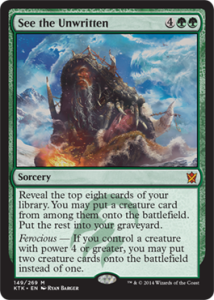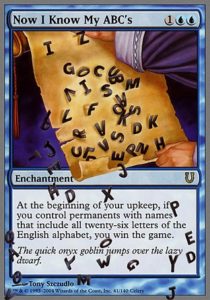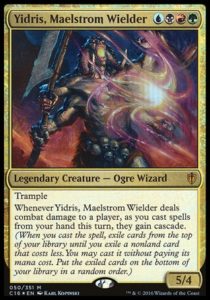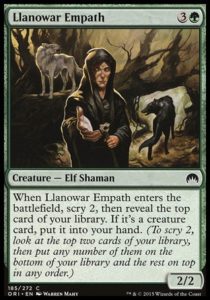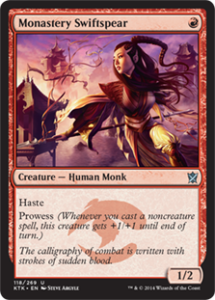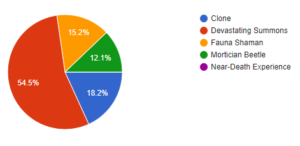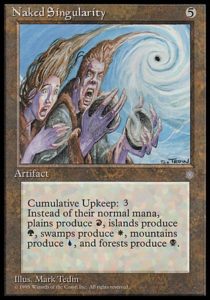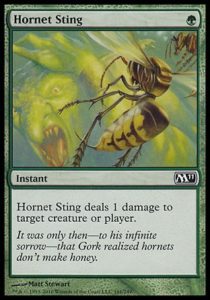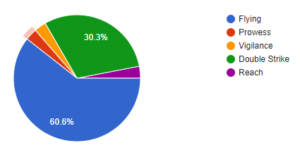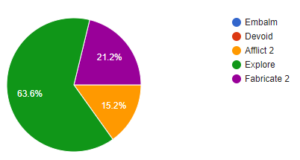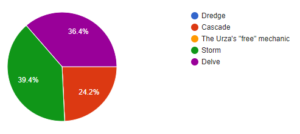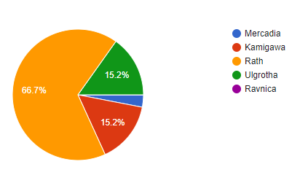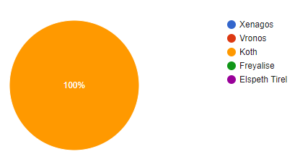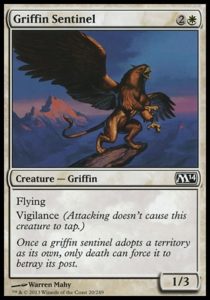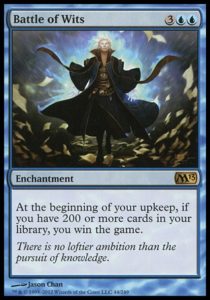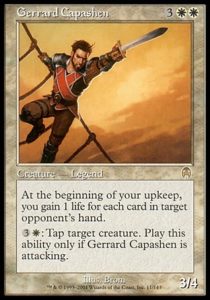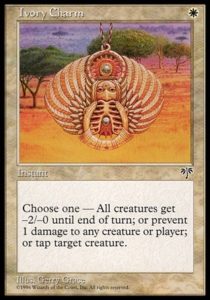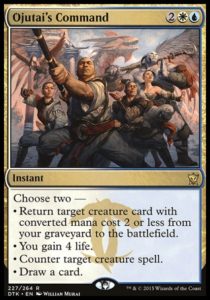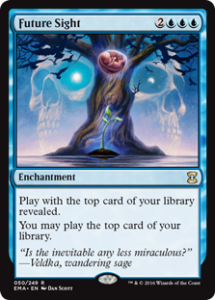Welcome to 2018 and Rivals of Ixalan spoiler season, friends! We’ve got two weeks to go before the third Great Designer Search begins, so let’s get cracking! As usual, we’ll start with this week’s new assignments and then go over last week’s. Here’s the submission form for our brave competitors. Now let’s get cracking!
Research Essay Assignment
The first hurdle of GDS is a series of ten essays. This weeds out folks who aren’t serious about the competition right quick, as well as requires participants to demonstrate their voice, vision, style, and basic writing skills. This week’s assignment is a big two-parter.
First, I want you to read Mark Rosewater’s response to the GDS2 essay assignment. Then, read at least three of the GDS2 finalists’ essays.
Second, I want you to write ten 250-350 word essays (some of which are almost certainly going to be in the GDS3 essay competitions, and most of which were GDS essay questions). You do not have to submit these to me, though I find having external pressure beneficial to getting things done in advance. You’ll have a week to do this, which is the same amount of time you’ll have to craft and submit your GDS3 essays (and again, I expect several of these essays to actually be part of GDS3).
I intend to feature perhaps three or four essays next week (so not every question will get a featured essay). Getting featuring will be opt-in only. If you’d like one (or all) of your essays to be considered for being featured, please have the first word of each of those essays be BORK (because the Swedish Chef is awesome and it’s not exactly a common word). I promise to read everything everyone submits, but will only feature essays that people consent to being posted publicly.
- Introduce yourself and explain why you are a good fit for this internship.
- You are instructed to eliminate a color from Magic. Which color do you remove, why, and how do you allocate its slice of the color pie?
- Explain three positive ways “mana screw” affects Magic.
- What block do you feel did the best job of integrating design with creative? What is one more thing that could have been done to make it even better?
- R&D has recently been looking at rules in the game that aren’t pulling their weight. If you had to remove an existing rule from the game for not being worth its inclusion, what would it be?
- You stumble upon a time machine and travel back to the early 90’s. What is the one change you would recommend Richard Garfield make with Alpha? (You must recommend a change.)
- What do you think design can do to best make the game accessible to newer players?
- What do you think design can do to best make the game attractive to experienced players?
- Choose a plane other than Dominaria, Mirrodin, Innistrad, or Ravnica. What is a mechanical twist we could add if we revisit this plane?
- Name a card currently in Standard that, from a design standpoint, should not have been printed. What is the card and why shouldn’t we have printed it?
Callback Assignment: GDS2 Question 29
This was the second most missed question in GDS2 (but was expected to be the most missed question). Think you can figure it out?
29) Which of the following enchantments are we least likely to print?
a) All creatures with changeling have flying.
b) All creatures with echo have deathtouch.
c) All creatures with exalted have lifelink.
d) All creatures with infect have first strike.
e) All creatures with landfall have haste.
GDS-esque Questions
Question #1: Which of the following is not deciduous?
a) Hybrid mana
b) Cycling
c) Curses
d) Double-faced cards
e) Protection
Question #2: Which of the following is currently in blue’s color pie?
a) Vigilance
b) +N/-N on creatures
c) “Meddling” (name a spell, it can’t be cast)
d) Pinging (repeatable direct damage)
e) “Can’t block”
Question #3: Which is a true statement about the Magic psychographics?
a) Vorthoses care about Magic lore.
b) The majority of cards are designed for Spike.
c) The majority of cards are designed for Tammies & Timmies.
d) R&D doesn’t have to create cards specifically for Spikes, since they’ll gravitate towards the best cards.
e) Johnny and Jenny refer to different kinds of players.
Question #4: Lore! (I don’t expect GDS3 to go too in-depth on this, but you all aced last week’s lore question, so here we go.) Which is a false statement about Magic’s story?
a) Chandra is the abbot of an ancient organization of monks.
b) Jace was once an accomplished blademaster.
c) Ral Zarek, Vraska, Jace, Tezzeret, and Liliana have all worked for Nicol Bolas.
d) Sarkhan Vol was never born.
e) Emrakul was defeated on Innistrad by Tamiyo and the Gatewatch.
Design Challenge
1: Lucky spell
Design an uncommon sorcery with exactly seven words.
2: Minimalism
Design a rare creature with four words, none of which are keywords, ability words, or keyword actions.
3: Acrophobia
Design an enchantment named Acrophobia,
4: Return to Tarkir
Magic returns to Tarkir. For the sake of flexibility, let’s say that both the Khans and Dragons timelines are viable to be returned to. Design a common with a new mechanic for one of the ten possible clans (wedge Khans clans or allied-color Dragons clans).
5: Evasion
Design a creature with a form of evasion never seen before.
Happy Designing!
You can submit all of your responses here. And now, let’s get to last week’s questions!
Callback Assignment: GDS2 Question 46
As was the case with GDS2, a slim majority of respondents got this question correct, though our percentages (and sample size) are a tad different. Click here if you’d like to see Rosewater’s reasoning for this question. Here’s my fast take on the answers, if you’d like.
Fauna Shaman is a totally Jenny card. She is not only a toolbox in and of herself, she allows your deck to be a toolbox. I suspect folks who guessed her may have misread the question to read “most Johnny” rather than “least.” That’s a common trick in questions.
Near-Death Experience is a wonky alternate win condition that involves crafting a specific, unlikely scenario. That’s a Johnny card.
Clone is less overly combo-oriented and more in Spike territory, but it offers a ton of flexibility and unusual interactions. There are a ton of things one can do with Clone and you’ll need to both craft your deck to take advantage of it and be able to concoct a plan on the fly.
Mortician Beetle is a build-around card, though a less dynamic one than the aforementioned. I think it’s the second-least Jenny card of this list, but it is still very much a cog in an engine for an unusual deck, rather than an overtly powerful (Spike) or intrinsically exciting (Tammy) card.
Devastating Summons isn’t that difficult a puzzle, nor can it do many things. It asks, “How much will I sacrifice to kill my opponent,” which is a Spike question. This differs from Mortician Beetle because it both gives you the means to sacrifice things and has a rather consistent answer (all of them).
[Carrie’s editorial note: I believe both Zach and Mark Rosewater are wrong. The correct answer is Clone, which is not a Johnny card at all. Jennies play cards that do things they want to do, but Clone doesn’t do anything except reinforce what’s already happened. I’m a Spike, so what do I know about Jennies? But it is not accurate to say that you “need to craft your deck” around Clone to take advantage of it. The whole point of the card is that it works with anything and can copy opponents’ cards if you don’t draw something you want to copy, and in fact it’s usually better in that role than as a combo card. Phantasmal Image is Clone priced for constructed play. Spikes love Clone in Limited. If R&D thinks Jennies love Clone, that might be a problem with their design process. I wrote about something similar in this article about the perceived problems of BfZ limited. Broodhunter Wurm is not that different from Clone.]
Research Assignment: The Color Pie
For this assignment, I asked players to consider three ways that the color pie has changed in the last five years.
The most common answer was new abilities such as Fight, Prowess, impulsive draw, planeswalker destruction, and Afflict. Of all of the new abilities, I think Fight is one of the most substantial because it both undermines and plays into green’s biggest weakness (green is bad at killing creatures, unless it has its own creatures).
Several abilities shifted or bled into new colors: Reach (now secondary in red), land freezing (originally black, now only in red), Menace (now keyworded and in black). We’ve also seen tribes bled into new colors temporarily, as in Innistrad (blue zombies), Amonkhet (white zombies), and Ixalan (white vampires, green merfolk).
Individual cards also hinted at new directions colors may go in, or were just very odd one-offs: The Great Aurora, Sandwurm Convergence, and Descent of the Dragons.
I received very few answers about color pie philosophy shifts, which I was excited to discuss. I think that there have been major philosophical shifts in the color pie (partly to accommodate formats like EDH which have very different requirements of the color pie). Green has gotten superb card advantage in Tireless Tracker, Collected Company and cantrips in Oath of Nissa and Attune with Aether (which is basically “draw 1 and 2/3 cards” for one mana), essentially beating blue at card advantage for two years. While Mentor of the Meek and Puresteel Paladin were once color pie breaks in white (given that white could do almost everything else, it was denied card advantage), white is now allowed to have build-around card advantage engines like Sram, Senior Edificer. Black was always supposed to be the best color at killing creatures, but was always worse than red and white in nonrotating formats and often in Standard. With the printing of Fatal Push, Wizards has given black mages a major boon and suggested that they will continue to try to properly frame black as best at killing creatures.
GDS-esque Questions
Question #1: One of the following abilities is given to a creature of unspecified color. Which ability will most likely increase the creature’s mana cost by one mana?
a) Flying
b) Prowess
c) Vigilance
d) Double Strike
e) Reach
This summer, I wrote about how much abilities tend to cost, specifically Flying, Prowess, Vigilance, and Double Strike. The majority of respondents got the answer correct. The most common incorrect answer was Double Strike, which will increase the creature’s mana cost, but most likely by two mana, rather than one. The other three abilities are unlikely to raise the creature’s mana cost by anything (by themselves), whereas flying almost always increases a creature’s cost by one.
Question #2: One of the following abilities is given to a creature of unspecified color. Which ability will most likely increase the creature’s mana cost by one mana? (That’s right, this is the same question, but with recent non-evergreen keywords.)
a) Embalm
b) Devoid
c) Afflict 2
d) Explore
e) Fabricate 2
Explore combines two effects, drawing a card (+2 mana) or +1/+1 counter (+1 mana). It’s random, so it’s marginally discounted. If you look at every creature with explore and give them the +1/+1 counter and the minor bonus of Scry 1, you’ll see that everything is properly (though aggressively) costed at +1 mana.
Fabricate 2 is the same trap of Double Strike. Giving a creature +2/+2 raises its mana cost by two, just like Double Strike tends to.
The remaining abilities tend not to increase a creature’s cost at all. Embalm has its own separate (and expensive) cost, so it barely affects CMC. Devoid does nothing, so it costs nothing. Afflict 2 was the tricky one, but if you looked at Spellweaver Eternal, Frontline Devastator, and Eternal of Harsh Truths (as well as pretty much every creature with Afflict), you’d likely notice that Afflict has barely any effect on a creature’s cost.
Question #3: Which of the following mechanics can best be balanced by mana cost?
a) Dredge
b) Cascade
c) The Urza’s “free” mechanic
d) Storm
e) Delve
This question was inspired by Blogatog, where Rosewater briefly touched on this issue. Dredge and the Urza’s “free” mechanic cannot be balanced by costing, as Dredge circumvents mana costs and the Urza’s “free” ability’s power increases as the mana cost increases.
Let’s see look at Rosewater’s recent comments about Delve and Storm. To print balanced Delve cards, you either need to have massive colored restrictions (restricting delve cards to monocolored decks and undermining the cost reduction) or massive initial mana costs (making the cards potentially playable in nonrotating formats and completely unplayable in Standard). To print fair Storm cards, even a hefty mana cost doesn’t really matter (since Storm decks are about at producing copious amounts of mana). So, you can’t really balance either mechanics via costing. You can balance them by effect, since cards like Dead Drop and Flusterstorm can never win the game, but that’s a different question than I asked.
Cascade is a very powerful mechanic (“draw a spell of N-1 mana cost and get that much mana” is amazing), but it is the most balanceable by mana cost (of these options). Cascade is strongest when on cheap spells, since you can guarantee what you’ll Cascade into (and it’ll almost certainly be a Hypergenesis or something else in that cycle). The more expensive a Cascade spell is, the more unpredictable the result and the harder it is to build your deck around it. Once you get above the 3 Cascaders, the only card that sees play is Bloodbraid Elf, and she’s bonkers because she’s so aggressively costed (a 3/2 Haste is worth 3 mana, and Cascade on 4 drop that’s already solid is fantastic).
[Carrie’s editorial note: I disagree and said Storm, because Mind’s Desire is weaker than Tendrils of Agony; or if it is stronger, that is only because it is blue and therefore combos with Force of Will. Maelstrom Wanderer is not “balanced” because it costs a lot. It’s just kept out of competitive play without being banned because it is too expensive and too random for Spikes to play with it. Cascade and the Cloud of Faeries mechanic are basically the same thing and both mechanics are degenerate. Cascade purported to be a “fixed” version of the “free” mechanic, but all it does is give you one less mana and less choice about what to cast with that mana. It still does the same thing, and fundamentally cannot be balanced by mana cost even if competitive prevalence makes us think it can be. That is why Bloodbraid Elf is banned in Modern, and why Violent Outburst is more likely to be banned than Living End.]
Question #4: Which of the following planes would be most difficult for Magic to revisit in a Standard-legal expansion?
a) Mercadia
b) Kamigawa
c) Rath
d) Ulgrotha
e) Ravnica
Mercadia, Kamigawa, and Ulgrotha have their fans, but overall both they and their associated sets were poorly received by Magic’s fans. None are likely to be returned to—I think Ulgrotha is least likely from among them, since Innistrad is already the Gothic horror plane—though I could see them returning in an Origins set. Rath no longer exists, so while it could be revisited in a prequel story (like Urza’s Saga and Kamigawa, which were set in the distant past), that would be a complete departure from Magic’s ongoing story.
Question #5: Lore question! Which of these planeswalkers is currently alive?
a) Xenagos
b) Vronos
c) Koth
d) Freyalise
e) Elspeth Tirel
Ah. Well done.
Design Challenge: New Vanilla
Design a common french vanilla creature for a core set that’s never been done before.
A french vanilla creature is one that has only creature keywords (like flying, first, strike etc.). Everyone grokked this requirement, though some folks designed uncommons and other folks designed color-shifted versions of cards that already exist (so, they technically succeeded at the assignment, if not the spirit).
Hatchet Man by Calvin Olson
4R
Creature – Human Barbarian
Double-strike
2/2
I didn’t expect to see any cards with double strike, since it’s complicated, powerful, and rarely done at common. Uncaged Fury and Two-Headed Cerberus were commons in recent memory (albeit not in core sets). I could actually see this in a core set specifically because it’s not aggressively costed.
Falling Tree by Daniel Blees
G
Creature – Treefolk
Trample
0/3
This is a head-scratcher in a normal set (I guess the set’s about +1/+1 counters or auras?), but in a core set, this is more likely to confuse and bother a new player than it is to teach them about trample. I think Magic is at its best when trample is on creatures with 2+ power in core sets.
Fearsome Ogre by Levi Byrne
5R
Creature: Ogre Berserker
Menace
5/1
Goblin Horde by Jeremy Geist
4R
Creature – Goblin Berserker
Menace
5/2
I really like both of these creatures. They’re simple, they work well with Menace, and they actually say a lot about red (its tribes, its focus on attacking, and how you can get advantage by forcing double doubles) as well as gently introduce the concept of multi-blocking (which most players don’t learn about) at the beginning.
Design Challenge: You Win
Design a rare with the words, “you win the game.”
Quest for Transcendence by Nathan Whalen
1UU
Enchantment (M)
~ enters the battlefield with a quest counter on it.
At the beginning of your upkeep, if the number of cards in your hand is equal to the number of quest counters on ~, put a quest counter on it. Then, if ~ has seven or more quest counters on it, you win the game.”
This is delightfully tricksy. This assignment was primarily looking for Jenny cards, and there’s a fun challenge to this card, as well as ways to accelerate the process (proliferation, extra upkeeps, and whatnot).
Abnegation by Carrie O’Hara
2WW
Enchantment
W, Exile a card from your graveyard: You gain three life. At the beginning of your upkeep, if you have no cards in your hand and no cards in your graveyard, you win the game.
I think Abnegation is too good for what it does, hitting as a pure Spike card. Pretty much every ‘you win the game’ effect requires a series of hoops to jump through, if not a thoroughly built deck. Even the odd ‘works by itself’ engine like Azor’s Elocutors is more wonky than potent. Abnegation does the hard part of the equation (emptying your graveyard) while making it less likely that you’ll die by normal means. This feels like Approach of the Second Sun, but way more aggressively costed.
The Final Countdown by Paul Smith
1RR
Enchantment
[Cardname] enters the battlefield with 10 time counters on it.
At the beginning of each player’s upkeep, remove a time counter from [Cardname]. When the last is removed this way, that player wins the game.
{3}: Flip a coin. If you win the flip, remove a time counter from [Cardname]. Any player may play this ability. When the last is removed this way, that player loses the game.
This is weird. It has coin flips (Tammy), an alternate win con (Johnny), and gives you ample opportunity to outthink your opponent. I really like it, but I can also imagine the headaches and surprises this causes.
Iterative Experiment by Jacob
1UR
Sorcery
Draw a card. If this is the fifth time a spell named Iterative Experiment has resolved under your control this turn, you win the game.
“All right – next time, I’m sure we’ll get it!”
It’s Biovisionary the spell! I love it.
Now or Never by Sidney Parham
3UU
Enchantment (R)
When Now or Never enters the battlefield, target opponent takes three extra turns after this one.
At the beginning of your upkeep, you win the game.
I have very mixed feelings about Now or Never. I love the concept. I think if this cost more, it’d be far more dangerous (ramp into this on T4 on the play and some decks will never be able to kill you by their T6), but that’s a development concern. I worry that hoop is a bit too easy to circumvent (Stifle your trigger) and that it encourages the worst kind of prison cards to function.
Overall, I think this was a very difficult assignment and for good reason. We don’t often see these kinds of cards. They’re wonky, tend to be tournament unplayable (with Approach of the Second Sun being a very recent exception), and they’re dangerous when aggressively costed.
Design Challenge: Pop Culture
Design a Magic card inspired by (or of) a character from popular media.
This is hard, and Gerrard Capashen is an excellent example of why. When we know a ton of things about someone, we want to encapsulate everything we know about them, so we make these unwieldy, text-filled messes. A good designer will find the most resonant, essential parts of the character and use those. Fail, and well, you get Gerrard Capashen.
Warning: This section might contain spoilers about pop culture characters.
I particularly enjoyed reviewing designs that I didn’t recognize the references of, didn’t know the source material, or didn’t need to see an explanation to grok it. I loved feeling like I “got it,” even when I didn’t know what I was looking at—that’s strong design.
Buffy, the Vampire Slayer by Lance C
3WW
Legendary Creature – Human Slayer
Protection from vampires
Whenever Buffy, the Vampire Slayer deals combat damage to an opponent, destroy all vampire creatures that player controls.
5/5
Buffy slays vampires. Sometimes simple and clean wins the race. (And yes, MaRo thinks Buffy’s green, but this design doesn’t need to be, nor can it.)
Rock Man by Daniel Blees
1UR
Artifact Creature – Human Construct
XUR, T: CARDNAME deals X damage to target creature. If that creature would die this turn, exile it instead. CARDNAME has all activated and triggered abilities of cards exiled with it.
2/2
Yup, that’s Mega Man/Rock Man. I like how this captures the essential quality of the character, though I think I’d hate it being in play. Setting aside the aggressively costed ability, there are few abilities Rock Man will copy that will be better than his existing one. It’s strange that so much of the ability is basically trinket text, but the Spike nature of this design likely overwhelms its Jenny potential.
Eleven (Rare) (from Stranger Things) by Jake
1UB
Legendary Creature – Human Wizard
1/1
Tap, Pay 1 life: Tap or untap another target permanent.
Pay 5 life: Untap Eleven.
Full disclosure: I’ve never seen Stranger things. I’m guessing that Eleven is psychic, and can either draw power from others or hurt themselves to power up? This design confuses me, but perhaps if I knew the source material, it’d make perfect sense. I quite like the restraint shown in giving this creature two short, synergistic abilities.
Sphinx’s Riddle by Jack S
3WU
Sorcery
Draw three cards, then you may reveal a human creature card. If you do, you gain 5 life.
This is one of my favorite submissions. It’s so simple, but it’s so smart! You do have to get what it’s referencing to make sense, but when you do, it’s delightful. I wouldn’t be surprised if we see something quite like when we return to Theros.
[Carrie’s editor’s note: the Riddle of the Sphinx is not exactly “pop culture” but I love this card anyway.]
Edward Elric, Fullmetal Alchemist by Glen Vaughn
1RW
Legendary Creature – Human Soldier RARE
2: Until end of turn, target noncreature artifact becomes an equipment and gains “”Equipped creature gets +X/+0, where X is this artifact’s converted mana cost”” and “”Equip 0″”.
3/1
The most notable thing about this character is that he transmutes almost anything around him into weapons, including his own prosthetic arm.
I haven’t watched FMA since I was quite young (to the point that I didn’t quite recall what Edward actually does), but I don’t think I need to. This person turns things into weapons. Bludgeon Brawl on a creature is a very neat idea that I expect to see one day.
Intrepid Raider by Skyler Nichol
UWR
Creature – Human Rogue
First Strike
Whenever ~ deals combat damage to a player, gain control of target artifact that player controls.
Whenever an artifact enters the battlefield while ~ is in your graveyard you may pay 1. If you do, return ~ from your graveyard to the battlefield.
4/2
“That belongs in a museum!”
Indiana acting like a thief makes perfect sense. I’m a little thrown by the reanimation ability—I guess Indiana comes out of retirement whenever some new treasure is discovered? I understand the nonstandard templating (it cares about artifacts entering the battlefield under anyone’s control), but it almost feels like Intrepid Raider should only care about when your opponents get artifacts (since presumably your side is the museum where everything belongs.
Dramatic Entrance Giant by LuxTheOmnicaster
3RRR
Creature – Giant mythic
When CARDNAME or another Giant enters the battlefield under your control, destroy target artifact or nonbasic land.
“You bet he and all his friends will come in like a wrecking ball.”
5/5
Oh yeah! Absolutely, completely hilarious, but also suitably mythic (though why isn’t it an Elemental or Weird?). Ironically, Dramatic Entrance Giant can’t have a Dramatic Entrance.
Chief Engineer Le Forge by Zachary Barash
1WU
Legendary Creature – Human Artificer
XWW: Return target artifact card with converted mana cost X from your graveyard to the battlefield.
1U: Look at the top card of your library. You may put it in your graveyard.
1/4
I’ve been watching all of TNG, so I went there. I like how this came out—it’s a twist on Hanna, Ship’s Navigator. Hopefully the concept of researching and/or prototyping to quickly find a solution came through.
Design Challenge: How Charming!
Design a charm (an instant with three modes, of which you must choose one).
The first two cycles of charms were one mana, and they had effects that cost less than a mana. Charms have certainly changed over the years, but the basic rule mostly holds true: charms cost N and have a choice of effects that cost N-1 or less. The tricolor Alara and Khans charms bent this a little because of their heavy color restriction, but even then, they never had a mode that cost more than N.
Hybrixis Charm by Bek
UBR
Instant
Choose one –
* Target creature can’t block or be blocked this turn.
* Target creature gets +2/+2 and gains first strike until end of turn.
* Discard a card. Draw two cards.
For funsies I made a charm where each mode is a hybrid of one of the color pairs. (The first one is a risky bend in black, but since the card isn’t actually hybrid I don’t have to be *that* strict with it.)
I don’t love Hybrixis Charm. The added restriction Bek gave themself led to a charm that feels like it’s doing too much at once. The first ability is essentially two modes, since it does two completely different thing. The second ability (which you wait to use until blockers are declared) is in tension with the first (which you use proactively). So the charm wants to be muck with combat, but it’s not clear when you’re supposed to use it. All together, I don’t know what kind of deck wants to use this charm. Not all charms are made for one kind of deck, but generally all three modes of modern charms feel like they should function together in a deck.
Ligneous Charm by Carrie O’Hara
1G
Instant
Choose one:
Search your library for a forest card, reveal it, put it into your hand, then shuffle your library;
Creatures you control get +0/+2 and gain reach until end of turn;
Target player shuffles their graveyard into their library.
This is a charm more akin to the early iterations of Mirage, Visions, and Planar Chaos, rather than those of RtR or Tarkir. I quite like it in this vein: it’s a bag of tricks that individually you’d never put in your deck but together form something that gives you options in unusual situations while normally having a right answer (fetching a forest).
New, improved Grixis charm by Blue ant
UBR
Instant
Choose one:
Draw 2 cards
Destroy target creature
~ deals 4 damage to target player and 2 damage to you.
Simple, clean, and brutally efficient. Divination + Murder + Char makes sense, and even though this may be a tad too strong, I like that the options are clean and feel they can all function in a contiguous deck.
Bear Charm by Daniel Blees
1G
Instant
Choose one –
Create a 2/2 green Bear creature token,
or target creature you control fights target creature you don’t control,
or target creature gains trample and hexproof until end of turn.
Ashcoat Bear + Pit Fight + a minor pump spell all feel good (and within the spirit of relating to bears). Yes, it needs a development pass, but it feels within the right ballpark.
Augury Charm by Justice Geddes
1WU
Instant
Choose one–
-Counter target spell unless its controller pays {1} for each creature you control.
-Exile target creature with power 4 or greater.
-Reveal the top four cards of your library. Put one of them into your hand and the rest on top of your library in any order.
I like how different it feels from Azorius Charm and the parallelism of four in the second and third abilities. The fact that it’s Impulse but reveals the cards feels unnecessary, but otherwise I like this.
Velocity Charm by Jacob
R
Instant
Choose one:
– Target creature gains haste until end of turn
– Target creature gains first strike until end of turn
– Exile the top card of your library. Until end of turn, you may play that card.
This is fantastic. Three simple effects worth less than a card that combined you’re happy to put in a deck.
Jace’s Charm by Sidney Parham
2UU
Instant (U)
Choose one –
* Draw two cards.
* Return target nonland permanent to its owner’s hand.
* Target player puts the top ten cards of his or her library into his or her graveyard.
Oooh! Weave Fate + Disperse + Glimpse the Unthinkable! I like it, and I like it at four mana.
Sovereign Charm by Alexander Smith
1(W/B)
Instant (Uncommon)
Choose one—
• Exile target card in a graveyard.
• Target creature gains indestructible until end of turn.
• Return target creature card with power 2 or less from your graveyard to your hand.
Not only is this a nice toolbox, but it manages to do so while being hybrid. Well done, Alexander!
Lifecrafter’s Charm by lpaulsen
G
Instant (Uncommon)
Choose one–
– You gain 2 life and get EE.
– Target artifact gains indestructible until end of turn.
– Pay any amount of E. Target creature gets +1/+1 until end of turn for each E paid this way.
I misread this when I first saw it. This is a pretty nifty design: a charm that basically wants to go in an aggressive energy deck. Giving an artifact indestructible feels odd because of the third ability, and the third ability is likely too much for one mana (in Standard, it seems facile to get 10+ energy), but I really like how it’s all tied together.
Design Challenge: So Commanding!
Design a command (an instant or sorcery with four modes, of which you must choose two).
Insidious Command
B
Instant (R)
Choose two:
– Target creature gets +1/+1 until end of turn.
– Target creature gets -1/-1 until end of turn.
– You lose 1 life and draw a card.
– Each opponent loses 2 life.
I wanted to flip the normal costing of charms and commands.
Ooooooooh. This is really nifty. I love how this combines minor black effects worth less than a mana, becoming a command that feels like a charm. I’d be excited to see a whole cycle of these. It’s really great seeing someone create something both new and familiar at the same time.
Nissa’s Command by Evan Shultz
3GGG
Sorcery
Choose two —
*Search your library for up to two lands and put them onto the battlefield. Shuffle your library afterward.
*Target land you control becomes a 4/4 elemental creature. It’s still a land.
*Put two +1/+1 counters on target creature.
*Target creature you control fights target creature you don’t control.
Nissa’s Command misses the mark for me because it lacks the synergy it feels it should have. You can’t turn the lands you fetch into creatures, you can’t put counters on the land you animate, and you can’t animate a land and fight with it. All of these problems can be fixed, but this card does a good job of underscoring how you should make sure a card both works the way you intend and whether it works the way other people feel it should.
Corrupted Command by Lance C
1B
Instant
Common
Choose two –
• You draw two cards.
• You lose 2 life.
• You sacrifice a creature.
• You discard two cards.
Lance C also designed a new kind of command: a build-your-own Night’s Whisper. I could see this in a Phyrexian set where entire card archetypes are subverted in ‘evil’ ways. That said, it would be hard to create equivalent versions in the other four colors. I like this idea, though I don’t love it as a command. Furthermore, you can circumvent the disadvantage by not having a creature to sacrifice (which feels too easy, particularly for something aggressively costed) and it lets you loot, which even though it makes sense in this context, isn’t something black does.
Bolas’ Command by Zachary Barash
3UBR
Sorcery
Choose two—
—Target player discards two cards.
—Destroy target creature.
—Put a creature card from an opponent’s graveyard onto the battlefield under your control.
—Bolas’ Command deals 7 damage to target player.
I wasn’t the only person to come up with a command for Bolas, but I want to bring this one up because it had several iterations. I wanted it to let you reanimate an opponent’s creature that you’d kill, but it couldn’t accomplish that via damage (since state based effects aren’t checked until the spell has resolved, you can’t reanimate what you burn). I made sure that the abilities were worded such that you’d have the maximum number of reanimation options and that the reanimation clause didn’t target (so you could reanimate something you destroyed or they discarded). That was a big pitfall for a lot of commands (they wanted their abilities to synergize, but they weren’t written in a way that allowed them to be synergistic).
We’re almost there, friends. As ever, thank you all so much for your comments, for your courage and creativity week after week, and for giving me WAY TOO MUCH TO WRITE ABOUT. This is an absolute blast and I can’t wait for all of our training to pay off once GDS3 begins.
—Zachary Barash
Zachary Barash is a New York City-based game designer. He works for Kingdom Death: Monster, has a Game Design MFA from the NYU Game Center, and does freelance game design. When the stars align, he streams Magic.
His favorite card of the month is Enter the Unknown from Rivals of Ixalan. It’s Explore, with Explore, but not in its name, and a touch more random.

